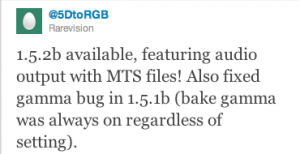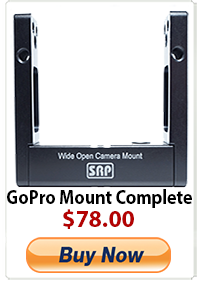In case you missed it: 5DtoRGB v1.5 [UPDATED]
**UPDATE 8-15-11** You must thank the power of social media and its reach to your audience. Less than 48 hours after I posted this video, Thomas from Rarevision contacted me about the gamma shift problem in the last release.
He was proud to announce that the new version has been made available to download with the problem fixed in this version. Check it out
I believe it was about a year ago when the developers at Rarevision came out with their way of prepping HDSLR media for post, 5DtoRGB. If you have been on a Mac workflow and transcoding to ProRes either via MPEGStreamClip, Magic Bullet Grinder, a variation of a Compressor droplet, or using the Canon E1 Log & Transfer plugin in Final Cut Pro 7, you know the woes of the wicked Quicktime gamma shift. Since most if not all HDSLRs that record video are recorded in a compressed format either H.264 or some form of AVCHD, at an 8bit color depth and also have a heavy amount of chroma subsampling; post production with these cameras can be an experience that is less than desirable. I wont go into the specifics about what this all means but if you want to read more into the alchemy of HD formats check out this blog post by Andy Shipsides of Abel Cine Tech about HD formats.
Okay. So we know that we are starting with a compressed codec in a limited color space and bit depth. This is where 5DtoRGB comes in to play. See below:
Uncompressed formats like DPX are useful for visual effects creation (like pulling mattes from green screen footage), as uncompressed files retain the most image quality. Furthermore, visual effects compositing programs like After Effects or Nuke work with RGB color (not YCbCr, which is common in HDSLRs), and so a YCbCr to RGB conversion must be performed by either QuickTime or your compositing program before anything useful can be done.
The big problem is that you have to trust your NLE or compositing app to do a good job of performing this YCbCr to RGB conversion. Many programs use QuickTime internally to perform YCbCr to RGB conversion which, according to our testing, does only a mediocre job. I suspect this due to a performance compromise, in that “well enough” is suitable for most users (remember, QuickTime is designed for real time playback of those 1080p movie trailers as well). This is probably OK for general use, but unacceptable when trying to maximize the quality of highly compressed H.264 footage for visual effects work, green screen compositing or film outs. To add insult to injury, QuickTime adds noise to its H.264 output (and so does any program that uses QuickTime to decompress H.264) in what looks like an attempt to cover up H.264 compression artifacts. And guess what? There’s no way to disable this. You’re stuck with it if you’ve converted your footage with Final Cut Pro, Adobe After Effects, MPEG Streamclip or Canon’s Movie Plugin-E1 for Final Cut Pro — all of them use QuickTime to decompress H.264. For an example of the result of this is, click here. via: Rarevision
5DtoRGB’s algorithm takes your HDSLR footage from the YCbCr color model and interpolates the chroma subsampling in the footage and transcodes it to a RGB color model. This new file will play nicely with any NLE, compositing software, or color correction suite. For more of the features of 5DtoRGB please check out the short video above and then head over to the download site from Rarevision and pick up the program and try it out for your post workflow. Happy Shooting!










Pingback: Top-quality DSLR Plugin 5DtoRGB Goes Version 1.5 for Both Mac and Windows - NoFilmSchool
Pingback: 5DtoRGB v1.5 | Jonny Elwyn - Film Editor
Pingback: 5DtoRGB Update v1.53 - Wide Open Camera
Pingback: 5DtoRGB Update v1.53 « Wide Open Camera
Pingback: 5DtoRGB Update v1.53 « Wide Open Camera